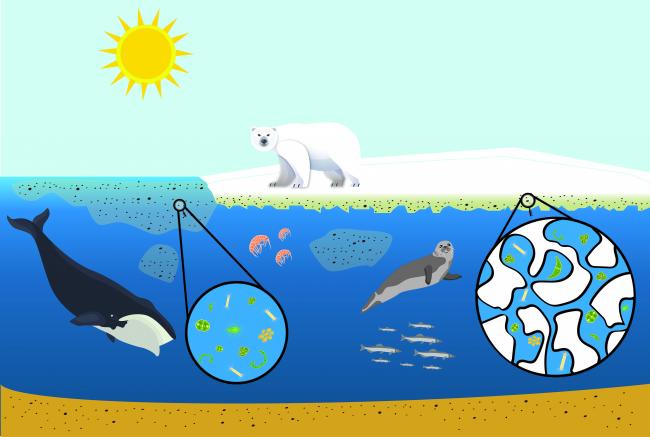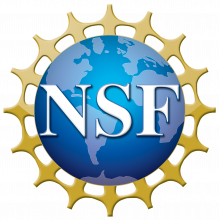The Arctic is warming more rapidly than anywhere else on Earth. One consequence of a warming Arctic is a dramatic decline in sea ice, an important habitat for many Arctic plants and animals. In this unit students will engage with 360° virtual reality tours, hands-on labs, and authentic Arctic datasets as they gather evidence to construct explanatory models for the unit driving question, "How might the decline in sea ice affect Arctic organisms large and small?"
- Find the Unit Summary here
- Find the Unit Storyline here
- Find the Instructional Calendar here
Past Teacher Workshops
For more information about the curriculum, please refer to the recording and time stamp document below from our August 2021 teacher workshop. Also included is the whole group landing page of resources (Padlet) referenced in the recording.
Context for Use
This 8-lesson middle/high school unit is centered around the anchoring phenomenon of a changing Arctic ecosystem, with each lesson time to NGSS Life Science Standards.

Arctic food web
Goals Header
Big Ideas
- Ecosystem disruptions (sea ice decline) can lead to shifts in all its populations.
Teaching Materials
Description
In this 2-day lesson, students work in pairs to construct initial descriptive models and explanations for the unit driving question, “How might the decline in sea ice affect Arctic organisms large and small?”
- Driving Question(s):
- Why should we care about Arctic organisms?
- What Students Will Do:
- Develop a model to explain how declining sea ice (disruption) might change the Arctic ecosystem
- Ask questions that arise from observations of declining Arctic sea ice to seek additional information about the impact of this change on the Arctic ecosystem
Lesson 2: Arctic Feeding Relationships
In this lesson, students construct an Arctic food web to predict/explain how a disturbance (declining sea ice) might affect these interdependent feeding relationships.
- Driving Question(s):
- How do disturbances (declining sea ice) impact food webs?
- What Students Will Do:
- Model relationships between species and explain the impacts on these relationships if/when disturbances occur
Lesson 3: Photosynthesis Investigation
In this 2-day lesson, students will conduct a photosynthesis investigation and analyze satellite imagery to explain how declining sea ice has changed the amount of sunlight reaching the Arctic.
- Driving Question(s):
- Can plants do photosynthesis (produce food/energy) without light?
- Has the decline in sea ice impacted the amount of sunlight reaching the Arctic?
- What Students Will Do:
- Carry out an investigation to determine if light affects the ability of plants (algae) to do photosynthesis.
- Analyze and interpret satellite imagery to explain how and why declining sea ice has changed the amount of sunlight absorbed by the Arctic.
Lesson 4: Shifting Algae Populations
In this lesson, students analyze authentic Arctic data to evaluate how shifting Arctic algae populations could affect the rest of the Arctic food web.
- Driving Question(s):
- How have ocean algae and sea ice algae populations changed over time?
- How might the changing Arctic algae populations affect the rest of the Arctic food web?
- What Students Will Do:
- Analyze and interpret Arctic primary productivity datasets to evaluate how changing algae populations might affect the rest of the Arctic food web.
Lesson 5: Tracing the Flow of Carbon Through the Arctic Food Web
In this lesson, students analyze and interpret the flow of carbon-based fats through the Arctic food web to determine which organisms depend on food chains that start with ocean algae and which organisms depend more on food chains that start with sea ice algae.
- Driving Question(s):
- Which producer (ocean or sea ice algae) is more important to organisms in the Arctic food web?
- What Students Will Do:
- Trace the flow of energy through the Arctic food web by analyzing and interpreting carbon-based fats (ocean vs. sea ice algae) stored in Arctic animals
Lesson 6: Putting Pieces Together
In this lesson, reflect on previous lessons to determine which concepts and evidence are important in explaining the unit driving question, "how might the decline in sea ice affect Arctic organisms large and small?"
- Driving Question(s):
- What evidence do we have to explain the unit driving question, "How might the decline in sea ice affect Arctic organisms large and small?"
- What Students Will Do:
- Construct and present a written and oral argument supported by citing empirical evidence and scientific reasoning that declining sea ice (disturbance) might change the Arctic food web
Lesson 7: Final Model Construction
In this lesson, students work in pairs to construct a final explanatory model for the unit driving question, "how might the decline in sea ice affect Arctic organisms large and small?"
- Driving Question(s):
- Why do scientists continue to gather evidence and revise models of phenomena?
- What Students Will Do:
- Develop a model to explain how declining sea ice (disruption) might change the Arctic food web
In this lesson, students work individually to develop a written evidence-based explanation for the unit driving question, "how might the decline in sea ice affect Arctic organisms large and small?"
- Driving Question(s):
- Why is science communication important in encouraging evidence-based decision-making?
- What Students Will Do:
- Construct an explanation based on qualitative and quantitative evidence for how the decline in sea ice (disruption) might change the Arctic food web


